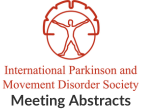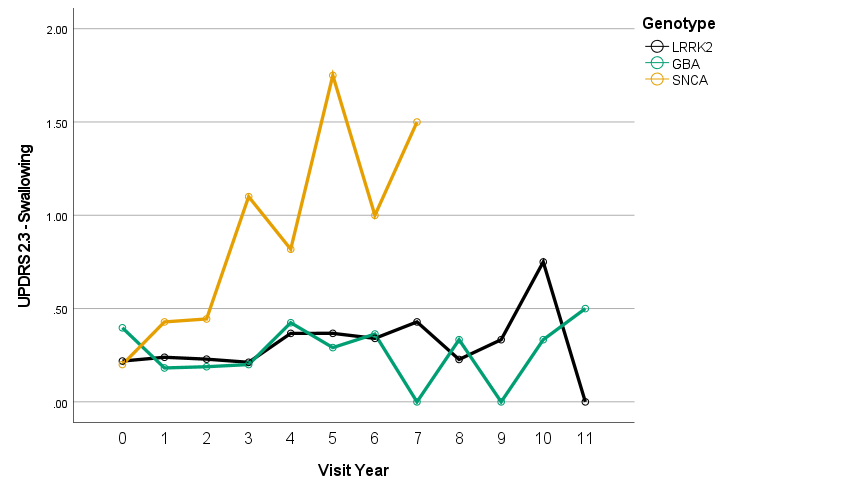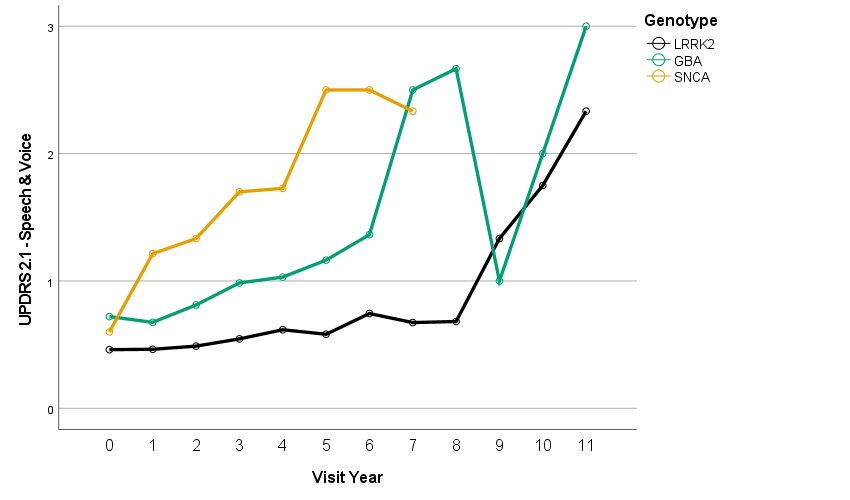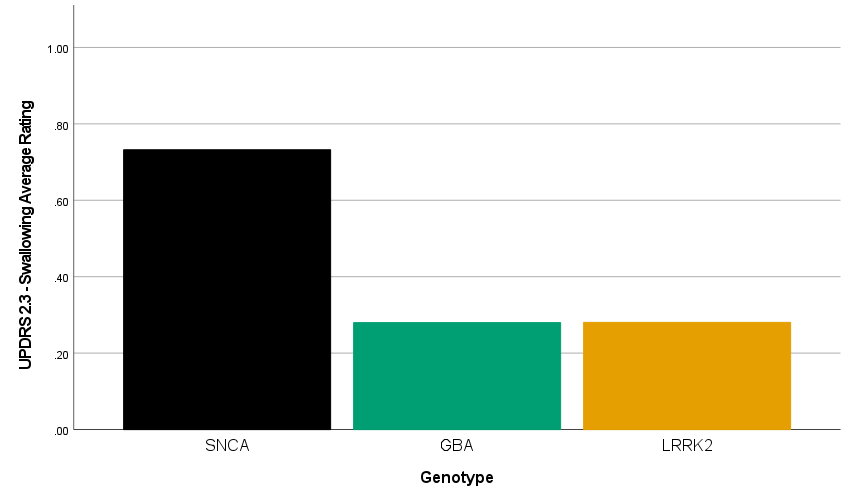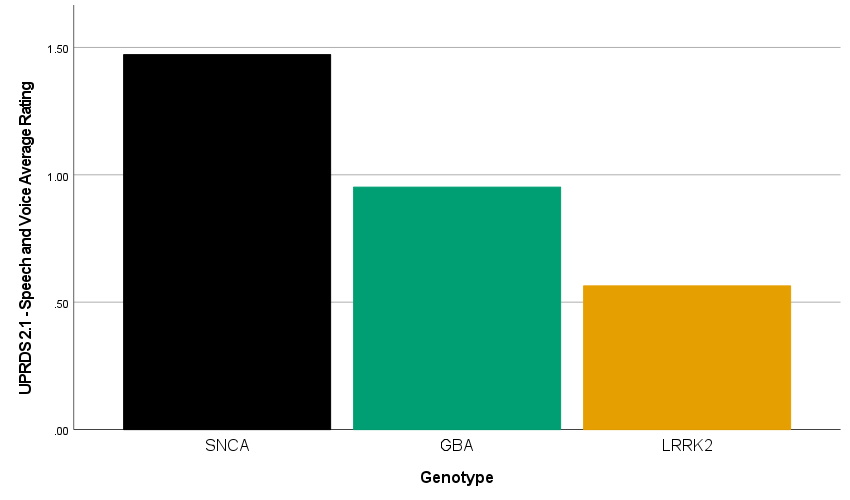Category: Allied Healthcare Professionals
Objective: The objectives of this project were twofold: 1. Determine how genotypes of Parkinson’s Disease (PD) affect voice & swallowing function, and 2. Examine how genotypes affect longitudinal progression in voice & swallowing symptoms.
Background: The majority of people with PD (PwPD) will experience voice & swallowing impairment at some point in the disease process. Despite knowledge of the importance and complications of voice & swallowing in PwPD, research into how individual patient and disease factors such as genotypes contribute to voice & swallow impairment lags other fields. Given this gap, we aimed to investigate how voice & swallowing impairment may manifest in different genotypes of PD.
Method: The Parkinson’s Progression Markers Initiative (PPMI) data set was used to examine patient reported symptoms of speech & voice and swallow impairment in LRRK2, GBA, & SNCA genotypes. Patients that were genotyped and obtained speech & voice and swallow symptom reports from the UPDRS and SCOPA-AUT for at least four yearly visits were included in this analysis. Linear fixed effect modeling was used to examine differences between genotypes, & Repeated Measures Linear Fixed Effect Modeling was used to examine the interaction between genotype and speech & voice and swallow symptom reports over time. Montreal Cognitive Assessment (MoCA) scores were included as covariates in both models to control for cognitive impairment in patient self-reports.
Results: There was a significant effect of genotype on speech & voice related (p < 0.001) and swallow related (p < 0.01) UPDRS questions. LRRK2 genotyped patients had significantly better speech & voice and swallow reports than GBA & SNCA genotypes. There were also significant interactions between genotype and symptom reports over time (p < 0.001). LRRK2 genotyped patients reported significantly fewer speech & voice symptoms than GBA in years 3, 5, 7, & 8, and SNCA in years 3, 5, 6, & 7. UPDRS swallowing questions displayed the SNCA genotype reported significantly more swallow symptoms than LRRK2 and GBA in years 3 & 5.
Conclusion: Not only are there differences in self-reported speech & voice and swallow impairment in different genotypes of PD, but certain genotypes may experience faster deterioration in perceived voice & swallow function over time. Substantially more research needs to be done in the areas of voice & swallow function in genotypes of PD.
Swallow Function per Genotype by Year
Speech and Voice Function per Genotype by Year
Swallow Function Scores by Genotype
Speech and Voice Function Scores by Genotype
References: Arora, S., Visanji, N. P., Mestre, T. A., Tsanas, A., AlDakheel, A., Connolly, B. S., Gasca-Salas, C., Kern, D. S., Jain, J., Slow, E. J., Faust-Socher, A., Lang, A. E., Little, M. A., & Marras, C. (2018). Investigating Voice as a Biomarker for Leucine-Rich Repeat Kinase 2-Associated Parkinson’s Disease. Journal of Parkinson’s disease, 8(4), 503–510. https://doi.org/10.3233/JPD-181389
Berg, D., Schweitzer, K. J., Leitner, P., Zimprich, A., Lichtner, P., Belcredi, P., Brüssel, T., Schulte, C., Maass, S., Nägele, T., Wszolek, Z. K., & Gasser, T. (2005). Type and frequency of mutations in the LRRK2 gene in familial and sporadic Parkinson’s disease. Brain, 128(Pt 12), 3000–3011. https://doi.org/10.1093/brain/awh666
De Pablo-Fernández E, Lees AJ, Holton JL, Warner TT. (2019). Prognosis and Neuropathologic Correlation of Clinical Subtypes of Parkinson Disease. JAMA Neurol. 76(4):470-479. doi:10.1001/jamaneurol.2018.4377
Dumican M, Watts C, Drulia T, Zhang Y. (2022). Dysphagia Presentation, Airway Invasion, and Gender Differences in a Clinically Based Sample of People with Parkinson’s Disease. Dysphagia. doi:10.1007/s00455-022-10472-y
Dumican M, Watts C. (2020). Self-perceptions of speech, voice, and swallowing in motor phenotypes of Parkinson’s disease. Clin Park Relat Disord. 3:100074. doi:10.1016/j.prdoa.2020.100074
Faul, F., Erdfelder, E., Buchner, A., & Lang, A.G. (2009). Statistical power analyses using G*Power 3.1: Tests for correlation and regression analyses. Behavior Research Methods, 41, 1149-1160.
Guadagnolo, D., Piane, M., Torrisi, M. R., Pizzuti, A., & Petrucci, S. (2021). Genotype-Phenotype Correlations in Monogenic Parkinson Disease: A Review on Clinical and Molecular Findings. Frontiers in neurology, 12, 648588. https://doi.org/10.3389/fneur.2021.648588
Jankovic J. (2008). Parkinson’s disease: Clinical features and diagnosis. J Neurol Neurosurg Psychiatry. 79(4):368-376. doi:10.1136/jnnp.2007.131045
Klein, C., Hattori, N., & Marras, C. (2018). MDSGene: Closing data gaps in genotype-phenotype correlations of monogenic parkinson’s disease. Journal of Parkinson’s Disease, 8(s1). https://doi.org/10.3233/jpd-181505
Luo L, Andrews H, Alcalay RN, et al. (2019). Motor phenotype classification in moderate to advanced PD in BioFIND study. Parkinsonism Relat Disord. 65:178-183. doi:10.1016/j.parkreldis.2019.06.017
Ma A, Lau KK, Thyagarajan D. (2020). Voice changes in Parkinson’s disease: What are they telling us? J Clin Neurosci. Published online. doi:10.1016/j.jocn.2019.12.029
Marras C. (2015). Subtypes of Parkinsonʼs disease: state of the field and future directions. Curr Opin Neurol. 28(4):382-386. doi:10.1097/WCO.0000000000000219
Mehanna, R., & Jankovic, J. (2010). Respiratory problems in neurologic movement disorders. Parkinsonism & related disorders, 16(10), 628-638.
Mestre, T. A., Fereshtehnejad, S.-M., Berg, D., Bohnen, N. I., Dujardin, K., Erro, R., Espay, A. J., Halliday, G., van Hilten, J. J., Hu, M. T., Jeon, B., Klein, C., Leentjens, A. F. G.,
Marinus, J., Mollenhauer, B., Postuma, R., Rajalingam, R., Rodríguez-Violante, M., Simuni, T., … Marras, C. (2021). Parkinson’s disease subtypes: Critical appraisal and recommendations. Journal of Parkinson’s Disease, 11(2), 395–404. https://doi.org/10.3233/jpd-202472
Miller N, Noble E, Jones D, Allcock L, Burn DJ. (2008). How do I sound to me? Perceived changes in communication in Parkinson’s disease. Clin Rehabil. 22(1):14-22. doi:10.1177/0269215507079096
Plowman-Prine EK, Sapienza CM, Okun MS, Pollock SL, Jacobson C, Wu SS, Rosenbek JC. (2009). The relationship between quality of life and swallowing in Parkinson’s disease. Mov Disord. 24(9):1352-1358. doi:10.1002/mds.22617
Poewe, W., Seppi, K., Tanner, C. M., Halliday, G. M., Brundin, P., Volkmann, J., Schrag, A.E., & Lang, A. E. (2017). Parkinson disease. Nature Reviews Disease Primers, 3(1). https://doi.org/10.1038/nrdp.2017.13
Polychronis, S., Dervenoulas, G., Yousaf, T., Niccolini, F., Pagano, G., & Politis, M. (2019). Dysphagia is associated with presynaptic dopaminergic dysfunction and greater non-motor symptom burden in early drug-naïve Parkinson’s patients. PloS one, 14(7), e0214352. https://doi.org/10.1371/journal.pone.0214352
Polychronis, S., Niccolini, F., Pagano, G., Yousaf, T., & Politis, M. (2019). Speech difficulties in early de novo patients with parkinson’s disease. Parkinsonism & Related Disorders, 64, 256–261. https://doi.org/10.1016/j.parkreldis.2019.04.026
Puschmann A. (2013). Monogenic Parkinson’s disease and parkinsonism: clinical phenotypes and frequencies of known mutations. Parkinsonism & related disorders, 19(4), 407–415. https://doi.org/10.1016/j.parkreldis.2013.01.020
Ramig LO, Fox C, Sapir S. (2004). Parkinson’s Disease: Speech and Voice Disorders and Their Treatment with the Lee Silverman Voice Treatment. Semin Speech Lang. 25(02):169-180. doi:10.1055/s-2004-825653
Reed, X., Bandrés-Ciga, S., Blauwendraat, C., & Cookson, M. R. (2019). The role of monogenic genes in idiopathic Parkinson’s disease. Neurobiology of disease, 124, 230–239. https://doi.org/10.1016/j.nbd.2018.11.012
Sapir S, Ramig LO, Fox C. (2008). Speech and swallowing disorders in Parkinson disease. Curr Opin Otolaryngol Head Neck Surg. 16(3):205-210. doi:10.1097/MOO.0b013e3282febd3a
Silbergleit, A. K., Schultz, L., Hamilton, K., LeWitt, P. A., & Sidiropoulos, C. (2021). Self-Perception of Voice and Swallowing Handicap in Parkinson’s Disease. Journal of Parkinson’s disease, 11(4), 2027–2034. https://doi.org/10.3233/JPD-212621
Simons JA. (2021). Swallowing Dysfunctions in Parkinson’s Disease. In: Chaudhuri KR, Titova N, eds. International Review of Neurobiology. Vol 134. Nonmotor Parkinson’s: The Hidden Face. Academic Press; 1207-1238. doi:10.1016/bs.irn.2017.05.026
Stebbins, G. T., Goetz, C. G., Burn, D. J., Jankovic, J., Khoo, T. K., & Tilley, B. C. (2013). How to identify tremor dominant and postural instability/gait difficulty groups with the movement disorder society unified Parkinson’s disease rating scale: comparison with the unified Parkinson’s disease rating scale. Move Dis, 28(5), 668–670. https://doi.org/10.1002/mds.25383
Suttrup I, Warnecke T. (2016). Dysphagia in Parkinson’s Disease. Dysphagia. 31(1):24-32. doi:10.1007/s00455-015-9671-9
Sveinbjornsdottir, S. (2016). The clinical symptoms of parkinson’s disease. Journal of Neurochemistry, 139, 318–324. https://doi.org/10.1111/jnc.13691
Thenganatt MA, Jankovic J. (2014) Parkinson disease subtypes. JAMA Neurol.71(4):499-504. doi:10.1001/jamaneurol.2013.6233
Thijs, Z., Dumican, M., (2023) Laryngeal symptoms related to motor phenotypes in Parkinson’s disease: A systematic review. [under review].
Troche, M. S., Schumann, B., Brandimore, A. E., Okun, M. S., & Hegland, K. W. (2016). Reflex Cough and Disease Duration as Predictors of Swallowing Dysfunction in Parkinson’s Disease. Dysphagia, 31(6), 757–764. https://doi.org/10.1007/s00455-016-9734-6
Tysnes, O.-B., & Storstein, A. (2017). Epidemiology of parkinson’s disease. Journal of Neural Transmission, 124(8), 901–905. https://doi.org/10.1007/s00702-017-1686-y
von Coelln R, Shulman LM. (2016). Clinical subtypes and genetic heterogeneity: of lumping and splitting in Parkinson Disease. Curr Opin Neurol. 29(6):727-734. doi:10.1097/WCO.0000000000000384
Walker, R. W., Dunn, J. R., & Gray, W. K. (2011). Self-reported dysphagia and its correlates within a prevalent population of people with Parkinson’s disease. Dysphagia, 26(1), 92–96. https://doi.org/10.1007/s00455-010-9317-x
Watts, C. R., & Zhang, Y. (2022). Progression of Self-Perceived Speech and Swallowing Impairment in Early Stage Parkinson’s Disease: Longitudinal Analysis of the Unified Parkinson’s Disease Rating Scale. Journal of speech, language, and hearing research : JSLHR, 65(1), 146–158. https://doi.org/10.1044/2021_JSLHR-21-00216
To cite this abstract in AMA style:
M. Dumican, T. Reyers, A. Malczewski. The Effect of Genotype on Voice & Swallowing in Parkinson’s Disease: A Parkinson’s Progression Markers Initiative Study [abstract]. Mov Disord. 2024; 39 (suppl 1). https://www.mdsabstracts.org/abstract/the-effect-of-genotype-on-voice-swallowing-in-parkinsons-disease-a-parkinsons-progression-markers-initiative-study/. Accessed December 8, 2025.« Back to 2024 International Congress
MDS Abstracts - https://www.mdsabstracts.org/abstract/the-effect-of-genotype-on-voice-swallowing-in-parkinsons-disease-a-parkinsons-progression-markers-initiative-study/
